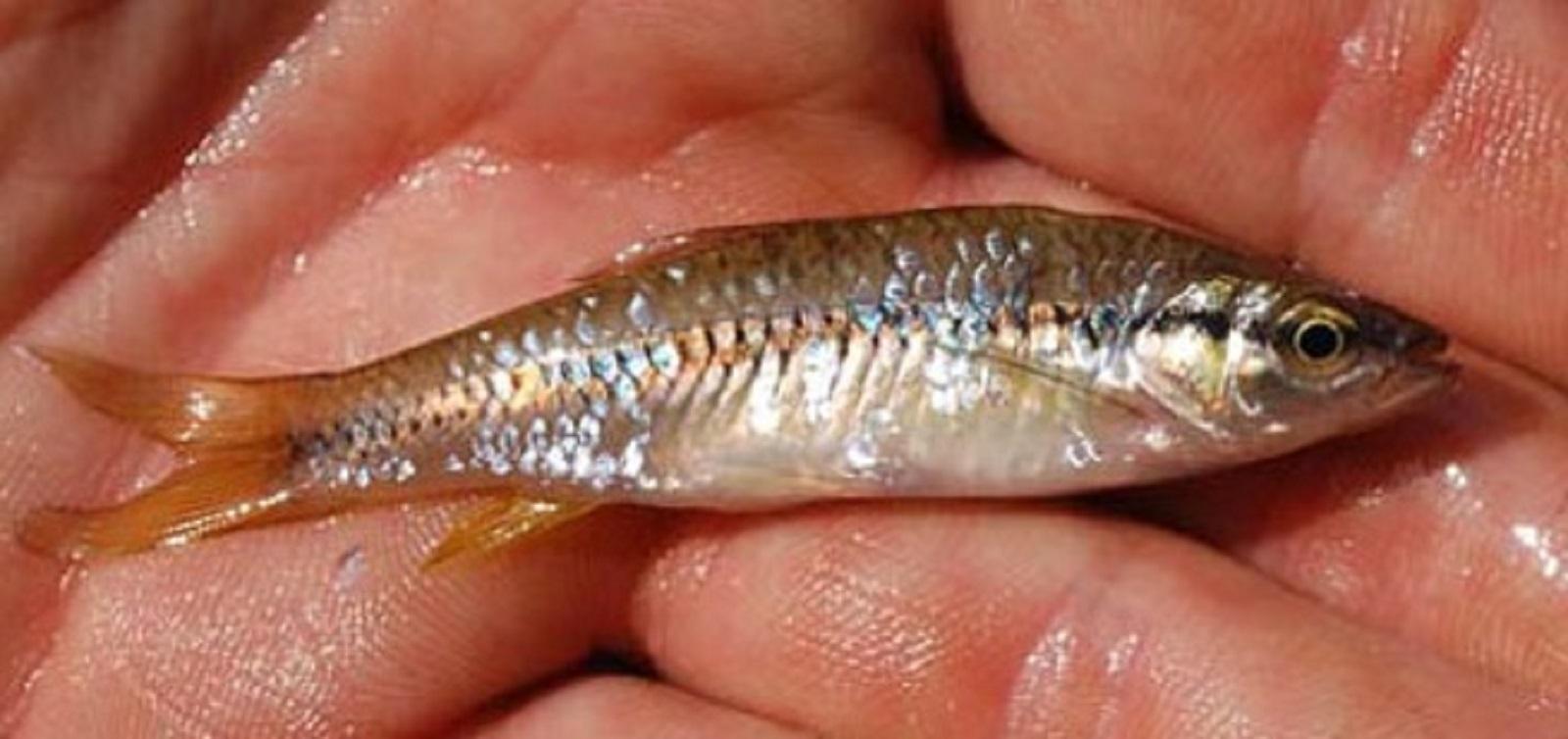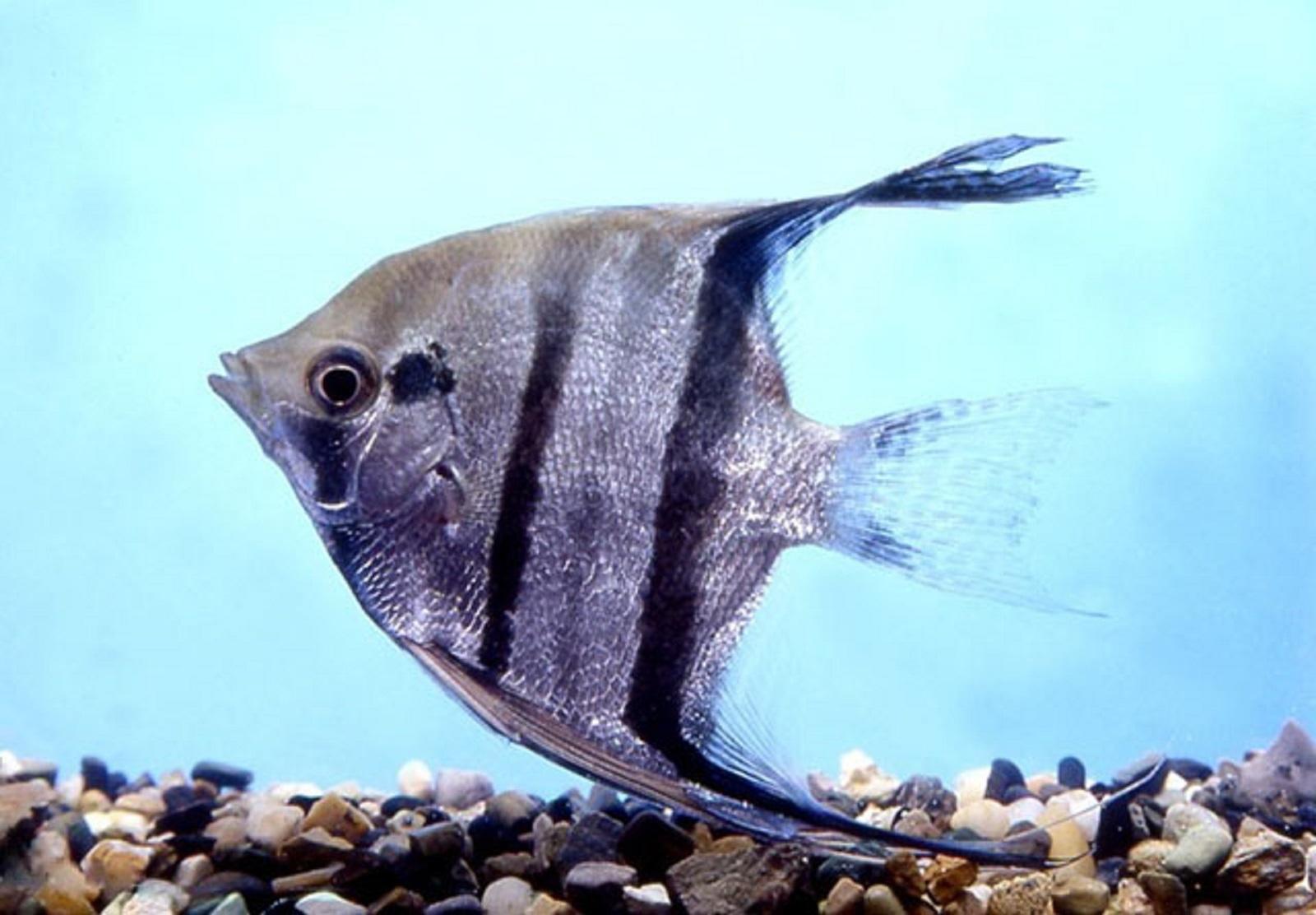Egg depositor of ornamental fishes
Egg depositor of ornamental fishes
Egg depositors deposit their eggs on the substrata including the glass tank, wood, rocks, plants, etc. Typically, it releases less number of eggs than the egg scatterers, however the eggs are larger. The Rasboras and angelfish are commercially important egg depositors.
Commercially important species
Slender rasbora

- Name of the species: Slender rasbora, Rasbora daniconius (Hamilton, 1822)
- Family: Cyprinidae
- Size: up to 15 cm
- pH: 6.0 – 6.5
- Temperature: 24 – 26oC
- Food habit: Carnivorous
- Distribution: only in India, Kaveri River, Karnataka
Description: The fish has an elongated body with a slight curve on the dorsal and ventral side. The body colouration is silver along with purple, green or yellow. A blue-black line runs from the head to caudal peduncle in the mid-body of the fish. The male fish has a yellowish tinge, and the female has slightly deeper colour.
Angelfish

- Name of the species: Freshwater angelfish, Pterophyllum scalare (Schultze, 1823)
- Family: Cichlidae
- Size: 12 – 15cm
- pH: 6.0 – 8.0
- Temperature: 24 – 30oC
- Food habit: Carnivorous
- Distribution: South America particularly Amazon and Guyana
Description: Has a laterally compressed disc-shaped body with large and elongated fins. The dorsal and anal fin stand tall and erect, but the caudal fin is fan-shaped. The iris of the eye colour is red. The colouration varies depending on the variety of fish.
Breeding and seed production
Rasbora
They are ideal for well-planted community aquarium where a shoal of 5-10 individuals looks very attractive as they swim actively at upper regions of water. The perfect temperature for spawning is about 25 – 28oC. They require soft and acidic water (pH6.5). For conditioning of the adults, the fishes are fed with high quality dried food and live feeds. After conditioning, the fishes are placed in a tank with flat leaved plants. If breeding does not take place in a week, separate the fishes for 15 days and reintroduce for breeding.
Typically, smaller size fish is recommended for aquarium or small-scale level, which lays about 100 eggs/ female. If the female is of bigger size, it may lay about 250 number of eggs. Once spawning occurs, the brood fishes are removed from the tank. The eggs hatch-out in 24 – 30 hrs. The new spawn starts to intake live feed such as Infusoria and Artemia after 3 – 5 days of post-hatchling. When they grown up they are fed with zooplankton such the Moina and Daphnia.
Freshwater Angelfish
The angelfish select their mating partner, and they will remain together for a year and lay eggs two to three times in a year. Usually, breeding occurs during March - May and in September. In mature fish, breeding can be stimulated by a partial water change and a rise in temperature to between 26 – 28 oC. One sure sign that spawning is about to occur is the appearance of the pair's genital papillae. These look like little nipple-like projections and are called ovipositors. The female's ovipositor is larger and blunter than the male's which is slender and more pointed. These protuberances, which appear at the vent, are used respectively for depositing eggs and fertilizing them. The distinct differences in the genital papillae are the first completely reliable indication of sex determination.
The pair will select a spawning site and thoroughly clean it for about two or three days before actual spawning takes place. When the cleanliness of the spawning site finally meets the approval of the parent fish, the female will make a few test runs. She will pull her ventral fins or feelers close to the lower sides of her abdomen, and her anal fin will be situated so that her entire lower line is relatively straight. Her ovipositor will then be able to make full contact with the slate, leaf or whatever was chosen for a spawning site. The male will then make a few practice runs too before the actual spawning takes place.
When spawning takes place, the female will pass over the site and eggs are deposited which adhere to the surface. The male then moves in, scoots along over the string of eggs just laid, and fertilizes them, his fins taking the same position as the females so he can press closely to ensure a higher fertilization rate. The male and female Angelfish will take turns making passes over the spawning site until several hundred or more eggs have been laid, depending on the size and condition of the female prior to spawning. The parents will hover closely over the spawn and fan continuously with their pectoral fins to create a circulation of water over and around the eggs. Some unfertilized eggs will turn white in a matter of hours and will be removed by the parents.
In some of the unmanaged tanks, if broods are kept for raising and if attained maturity, they lay eggs on the submerged sidewall of the tanks, and the parents subsequently eat those eggs. It is also seen that they lay eggs in the corner of the aquarium over silicon rubber gum. Therefore, it is necessary to know about the fish, its breeding season and its behaviour for one to be a commercial breeder.
There is a possibility of hatching eggs away from parents. For this, a tank (20 – 30 litre capacity) with a sponge filter and a piece of slate leaned up against a sidewall is required. The angelfish use the piece of slate to lay their egg. Later on, the fertilized egg plate is removed for hatching in an another tank. An addition of 3 – 4 drops of 10% methylene blue in the container helps newly hatched spawn to be free from fungi. The vigorous aeration is provided on each day after hatchling. Water may be replaced with aged taped water at the same temperature. Aeration can be slowed after the fry is free swimming. Hatching may occur in about 36 – 48 hrs depending on the water temperature. There will be a period after hatching and before free swimming when the fry will stick together. At this time increase the aeration so all the fry will have access to sufficient oxygen. During this period, feeding is not required until the fry are free swimming.
Angelfish fry can successfully be raised on a diet of newly hatched Brine shrimp (napulii) for the first four weeks of their lives and fed two to four times daily. After that, they are gradually introduced to a mixture of finely powdered Angelfish flakes and powdered dried bloodworms with an occasional (twice a week) feeding of brine shrimp. When their bodies are about the size of a quarter, they may be fed with Guppy fry. A simple way to provide this very nutritious food is to keep pregnant guppies in the same tank as the young Angels, and the rest is up to nature. Of course, feedings of other varied foods are needed to round out the diet.
References
- Ahilan, B., Felix, N. and Santhanam, R. 2008. Textbook of Aquariculture. Daya Publishing House, New Delhi.
- Ornamental fish production and management, online e-learning on Agricultural Education
- Swain SK., Sarangi, N. and Ayyappan S. 2010. Ornamental fish farming. Indian Council of Agricultural Research, New Delhi.
Last Modified : 7/1/2024
This topic provides details about species profile,...
This topic provides information about Breeding, la...
The topic provides information about the grow out...
This topic provides information related to culture...
